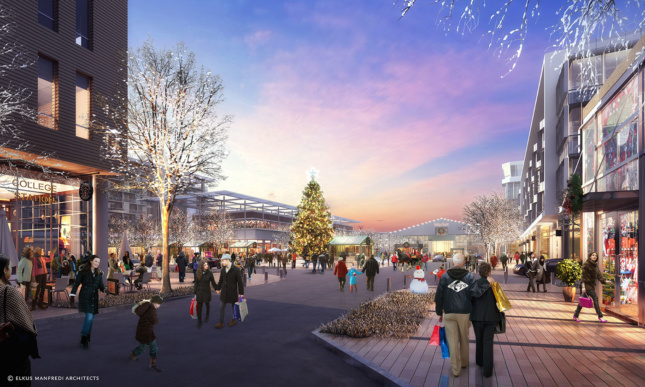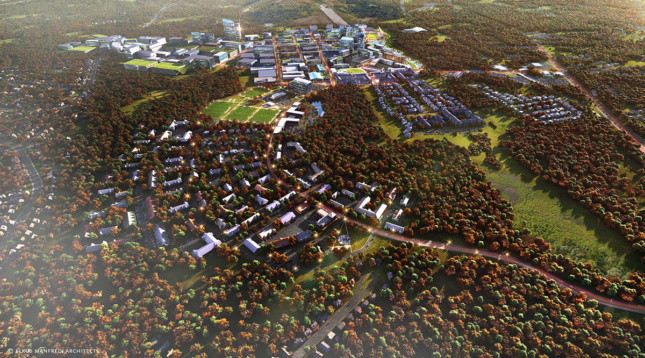In Boston, a booming job market is drawing people back from far-flung suburbs and remaking the region, but it is also exacerbating a housing-affordability crisis and forcing difficult conversations about the future of the city.
Greater Boston is riding a wave of development that is perhaps the largest the region has ever seen. By 2030, the city of Boston projects its population will top 700,000, a number it has not seen in 60 years.
“The vast majority of our growth is happening in the inner core of the Boston region, so within the city of Boston, Cambridge, Somerville, Everett, Quincy, and in some of the other municipalities within the Route 128 corridor,” said Eric Bourassa, director of the transportation division at the Metropolitan Area Planning Council (MAPC). “This is a trend we’ve been seeing over the past decade, and we’re just predicting more of this growth.”
The MAPC is in the process of updating the 30-year plan it released in 2008, highlighting housing, sustainability, and transportation. Another regional planning group, the Boston Region Metropolitan Planning Organization, is updating its periodic long-range regional transportation plan. But change is happening quicker than the region’s existing plans can reflect.
Data from the MAPC shows the region added more than 225,000 jobs between 2009 and 2015, and nearly two-thirds of them were in those inner-core cities. In July, the U.S. Bureau of Labor Statistics reported Boston’s non-farm employment rose 2.1 percent compared to the previous year, outpacing the national rate of 1.5 percent.
The engines of that growth are Greater Boston’s dozens of colleges and universities, and the biotech industry that grew out of them in the 1970s. Biotech turned Cambridge’s Kendall Square from an undeveloped urban frontier into a regional hub home to the highest concentration of biotech companies in the world, but many migrated to the area around Route 128 during the 1980s and ’90s to build suburban campuses.

Today some of the same genetic engineering startups that began that transformation, like Biogen, are reinvesting in Boston and Cambridge. That trend is likely to continue. Massachusetts Governor Charlie Baker recently announced his plans to put another $500 million into the life-sciences industry over the next five years.
In addition to Kendall Square, the South Boston Waterfront—better known as the Seaport—has gathered a growing share of those new jobs in a growing portfolio of pricey office developments and luxury condos.
Many suburbs are also becoming more dense. Needham, Natick, and Framingham are among the further-out cities developing around commuter rail stations in their downtowns. Two areas of Somerville are undergoing massive redevelopments tied to public transit, as well: Assembly Square, which recently landed the new offices of the state’s largest private employer, Partners Healthcare; and Union Square, which is preparing for major changes ahead of getting the first new MBTA train stop in decades.
Matthew Littell is principal of the Boston design firm Utile, which is working on the Cambridge Master Plan, and was a lead consultant on Imagine Boston 2030, Boston’s first citywide plan in 50 years. His firm analyzed demographic patterns in the region and found that younger employees in industries like tech tended to cluster around the inner-core cities and neighborhoods where they worked, compared to Boston’s bankers and lawyers, who still generally preferred houses in the suburbs.

Littell pointed to Autodesk’s decision to supplement its office space in the suburban Route 128 corridor with a new space in the Seaport.
“That’s a classic example, and the only reason these companies are moving is to attract and retain talent,” he said. “The young, smart folks don’t want to be out in Framingham or Waltham. They want to be in downtown Boston or Kendall Square or somewhere like that.”
MAPC socioeconomic analyst Sarah Philbrick agreed that young people are flocking to the inner-core cities in search of walkable neighborhoods and city life, and businesses are following them.
“Businesses want to attract these workers and therefore decide to locate in highly desirable locations,” Philbrick said. “I don’t believe many businesses would pay the high rents of the core if this were not the case.”
Real estate is booming along with the regional job market, but housing is coming up short, and local business leaders worry that could hobble their ability to attract top talent. Finding enough skilled employees is already an issue in a state with one of the nation’s lowest unemployment rates—soaring housing costs could drive away would-be residents.
“We just we don’t have enough housing to meet the demand,” said Bourassa, “and so we lose a lot of young professionals who can’t afford to live here.”
The MAPC estimates only about two-thirds of the region’s housing needs are being met.
Some worry that could lead to long-term stagnation or brain drain away from Greater Boston.

“I have a real question about how sustainable this rental housing boom is actually going to be in the long term,” said David Hacin, principal of Hacin + Associates. “There’s a lot of pent-up demand here, but it’s hard to build in the Boston area. It’s a very expensive market from a construction cost point of view, and when you combine years-long review processes with limited site opportunities because it’s a mature market, you run into problems of affordability.”
The City of Boston said it’s trying to address that problem. Mayor Marty Walsh has pledged 53,000 new housing units as part of a new housing plan—a sizable effort that may have contributed to median rent in the inner-core cities dropping for the first time since at least 2009.
Still, Barry Bluestone, professor of political economy at Northeastern University and lead author of the Boston Foundation’s Housing Report Card, estimates the region needs around 160,000 new housing units by 2030.
So far statistics show that efforts to ease the housing crunch are having mixed results. The pace of new housing construction in the same inner-core cities seeing the most population growth has slowed lately, according to the Foundation’s report card, published in November.
In its report, the Boston Foundation found that the City of Boston has issued more than 41 percent of the new housing permits in the region this year, almost double its share five years ago.
But fewer than one in five new units put on the market since 2011 were affordable, less than half the rate seen between 1996 and 2003. Meanwhile, the number of permits issued outside the city of Boston declined this year, while more than half of renters reported paying more than 30 percent of their income on housing, according to the report.
The region’s recent growth spurt may be making that problem more severe, but it should not come as a surprise, said Michael Goodman, executive director of the Public Policy Center at the University of Massachusetts Dartmouth.
“Population growth is contributing to some of the congestion and growth pressure being experienced in Greater Boston,” said Goodman. “But our transportation and housing issues are primarily the result of inadequate infrastructure investment and counterproductive zoning regulations which limit new housing development.”
With more people and corporations calling Boston home, housing advocates are calling on local governments to direct the benefits of a growing tax base into more affordable housing initiatives.
“Even in Boston, there continues to be a challenge of creating a housing stock that benefits working households along with everyone else who strives to live in the city,” said Barry Bluestone, lead author of the Boston Foundation’s housing report, in a statement.
He recommends the creation of “21st-century villages,” defined as multistory mixed-income buildings located near public transit. In an interview, Bluestone expanded on that idea. Many communities around Boston currently prohibit accessory dwelling units and, in some cases, ban multifamily housing outright, he said.
“In the past, everyone has acknowledged there’s a housing problem, but they’ve mostly looked to their neighbors to solve it,” said Bluestone.
Now that the whole region’s housing market is feeling the squeeze, however, more local governments are starting to take note. On December 5, municipal leaders from 14 cities and towns in the Boston area came together to identify a regional housing goal and recommend zoning changes to help them get there.
“I’ve been looking at housing for two decades, and I don’t think I’ve ever seen this kind of coordination,” said Bluestone.














